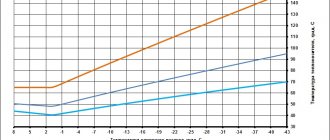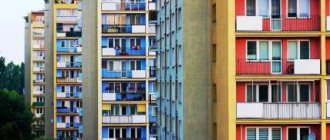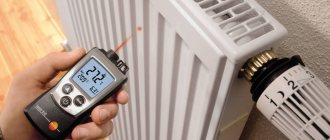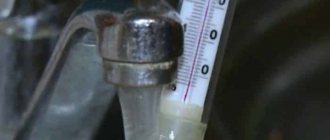Parameters for calculating heating systems: radiators
Heating optimization is related to the thermal output of heating devices.
Radiator batteries have an interval of 140-220 watts. The second parameter for calculation can be found in SNiP; to heat 1 square area, 100 watts are required. This is a rounded value; rooms differ in the degree of insulation.
Types of radiators
Cast iron radiators
Cast iron batteries have proven themselves well. Reliable, have good thermal characteristics. They are inert, take a long time to heat up, but take longer to cool down.
The power of cast iron radiators is calculated by sections; the heat output of one section is 150 watts.
Aluminum radiators
Good heat dissipation up to 200 watts per section, they heat up quickly, but are not durable. They have poor contact with other metals and begin to deteriorate upon contact. Operating temperature - 70 °C
Steel radiators
Good heating, does not have power characteristics like aluminum or cast iron. The power is indicated in the product passport, depending on the size and design: 200W-10kW. Designed to operate at a coolant temperature of 70 °C.
EFFECT OF TEMPERATURE ON COOLANT CHARACTERISTICS
In addition to the factors listed above, the temperature of the water in the heating pipes affects its characteristics. The method of functioning of gravity heating systems is based on this. As the water heating value increases, it expands and circulation appears.
COOLANTS FOR HEATING SYSTEMS
But when using antifreeze, exceeding normal temperatures in radiators can lead to different results. Therefore, for heating with a coolant other than water, it is necessary to first determine the permissible heating values. This does not apply to the temperature of the central heating radiators in the apartment, since such devices do not use antifreeze-based liquids.
Antifreeze is used if there is a risk of exposure to low temperatures on radiators. Unlike water, it does not change from liquid to crystalline at 0 degrees. But if the heat supply operation exceeds the norms of the temperature table for heating to a greater extent, the following phenomena may be observed:
- foaming This contributes to an increase in coolant volume and pressure level. There will be no reverse process when the antifreeze cools;
- the appearance of limescale. Antifreeze contains mineral components. If the heating temperature in the apartment is violated, they precipitate. Over time, this leads to clogged pipes and radiators;
- increase in density. Malfunctions of the circulation pump may occur if its rated power was not designed to handle such situations.
Therefore, it is much easier to monitor the water temperature in the heating system of a private home than to control the heating level of antifreeze. Moreover, substances based on ethylene glycol emit gases that are harmful to humans when evaporated.
Today they are almost never used as a coolant in autonomous heating systems. Before using antifreeze in heating, it is necessary to replace all rubber seals with paranitic ones. This is due to the high level of permeability of this type of coolant.
OPTIONS FOR NORMALIZING HEATING TEMPERATURE CONDITIONS
Minimum water temperatures in the heating system are not considered the main threat to its operation. This affects the microclimate in living rooms, but does not affect the operation of the heating supply. If the water heating norm is exceeded, emergency situations may occur.
SAFETY GROUP FOR AUTONOMOUS HEATING
When creating a heating scheme, you need to provide a list of measures aimed at preventing a critical increase in water temperature. First of all, this will lead to increased pressure and stress on the inside of pipes and radiators. If this happened once and lasted a short time, then the heating parts will not be damaged.
But such cases appear under the constant influence of specific factors. Most often this is the incorrect operation of a solid fuel boiler. To avoid breakdowns, it is necessary to upgrade the heating in the following way:
- installation of a security group. It consists of an air vent, a bleed valve and a pressure gauge. If the water temperature reaches a critical level, these parts will eliminate excess coolant, thereby ensuring normal circulation of the liquid for its natural cooling;
- mixing unit. It connects the return and supply pipes. Additionally, a two-way valve with a servo drive is mounted. The latter is connected to the temperature sensor. If the heating level exceeds the norm, the valve will open and a mixing of hot and cooled water flows will occur;
- electronic heating control unit. It distributes the water temperature in different parts of the system. If the thermal regime is violated, it sends a corresponding signal to the boiler processor to reduce power.
These measures will prevent improper heating operation at the initial stage of the problem. It is most difficult to control the water temperature in systems with a solid fuel boiler
Therefore, for them, special attention must be paid to the selection of indicators of the safety group and mixing unit
How to measure coolant temperature?
The temperature of the coolant in the heating system provides for the following standards:
- Hot water in the tap should be available all year round and its temperature should be from +50°C to +70°C;
- During the heating season, heating devices are filled with this liquid.
In order to find out the temperature of the heating radiator, you need to open the tap and place a container with a thermometer. At this time, the temperature may rise by 4°C.
When a problem arises in this matter, it is tedious to file a complaint with the Housing Office, but if the batteries are airy, the complaint is written to the DEZ. A specialist should come within a week to fix everything.
There are several more ways to measure the temperature of heating radiators in an apartment building:
- Using a thermometer, the temperature of the heating pipes or the radiators themselves is measured; 1 -2°C must be added to the result obtained;
- To measure data more accurately, you need to buy a thermometer-pyrometer that can measure temperature with an accuracy of 0.5°C;
- You need to take an alcohol thermometer and place it on a certain place on the radiator, then wrap it with tape and wrap it with any thermal insulator (foam rubber, flywheel). Now it will play the role of a permanent temperature meter of the heating system;
- In the case when you have an electronic measuring device at hand, for example, a multimeter, with a temperature measurement function, a wire with a thermocouple is wound to the radiator, and the temperature of the coolant is measured.
If you are not satisfied with the temperature of your heating devices or any other parameters of the coolant, then after filing a complaint a commission will come to you whose task will be to measure the temperature of the circulating fluid in the heating system.
They must strictly act in accordance with paragraph 4, which is specified in the “Control Methods” of GOST 30494−96, and the device must have registration, as well as verification and quality certificates. The measurement range should range from +5 to +40°C, the permissible error should be within 0.1°C.
Heat supply of a multi-storey building
Heating distribution unit for an apartment building
Heating distribution in a multi-storey building is important for the operational parameters of the system. However, in addition to this, the characteristics of the heat supply should be taken into account. An important one is the method of supplying hot water - centralized or autonomous
An important one is the method of supplying hot water - centralized or autonomous.
In most cases, a connection is made to the central heating system. This allows you to reduce the current costs in the estimate for heating a multi-storey building. But in practice the level of quality of such services remains extremely low. Therefore, if there is a choice, preference is given to autonomous heating of a multi-storey building.
Autonomous heating of a multi-storey building
autonomous heating of a multi-storey building
In modern multi-storey residential buildings, it is possible to organize an independent heat supply system. It can be of two types - apartment-based or communal. In the first case, the autonomous heating system of a multi-storey building is carried out in each apartment separately. To do this, make independent piping and install a boiler (most often a gas one). A common house installation involves the installation of a boiler room, which has special requirements.
The principle of its organization is no different from a similar scheme for a private country house. However, there are a number of important points to consider:
- Installation of several heating boilers. One or more of them must perform a duplicate function. If one boiler fails, another must replace it;
- Installation of a two-pipe heating system of a multi-storey building, as the most efficient;
- Drawing up a schedule for scheduled repairs and maintenance work. This is especially true for heating heating equipment and safety groups.
Taking into account the peculiarities of the heating scheme of a particular multi-storey building, it is necessary to organize an apartment-by-apartment heat metering system. To do this, energy meters must be installed on each incoming pipe from the central riser. That is why the Leningrad heating system of a multi-storey building is not suitable for reducing operating costs.
Centralized heating of a multi-storey building
Elevator unit diagram
How can the heating distribution in an apartment building change when it is connected to a central heating supply? The main element of this system is the elevator unit, which performs the functions of normalizing coolant parameters to acceptable values.
The total length of the central heating mains is quite large. Therefore, at the heating point, such coolant parameters are created so that heat losses are minimal. To do this, increase the pressure to 20 atm. which leads to an increase in the temperature of hot water to +120°C. However, given the characteristics of the heating system in an apartment building, supplying hot water with such characteristics to consumers is not permitted. To normalize the parameters of the coolant, an elevator unit is installed.
It can be calculated for both a two-pipe and a single-pipe heating system in a multi-storey building. Its main functions are:
- Reducing pressure using an elevator. A special cone valve regulates the volume of coolant flow into the distribution system;
- Reducing the temperature level to +90-85°C. A mixing unit for hot and cooled water is designed for this purpose;
- Filtration of coolant and reduction of oxygen content.
In addition, the elevator unit performs the main balancing of the single-pipe heating system in the house. For this purpose, it is equipped with shut-off and control valves, which automatically or semi-automatically regulate pressure and temperature.
You also need to take into account that the estimate for centralized heating of a multi-story building will differ from autonomous heating. The table shows the comparative characteristics of these systems.
How does a centralized heating system work?
With the onset of the heating season, apartment buildings are not connected to the system immediately, but one after another. Locksmiths go around the blocks and open special valves installed in the basement. Only after this is the hot coolant supplied to the riser and from there to the pipes and radiators. The number of gates is equal to the number of apartments. In the event of an accident or repair of the heating system in one of the rooms, you will not have to turn off the heat to the entire house. The hot liquid passes through the circuit, releases the accumulated heat through the radiators and returns to the boiler through a separate pipeline. According to current building codes, the temperature of the liquid in the system should be 130−150 °C. The exact value is determined taking into account the average winter temperature. In fact, the coolant in the pipes is a little colder, especially in older housing stock with worn-out communications. The temperature of the liquid in the “return” is on average 60 °C.
How coolant is supplied to the heating system
The following restrictions apply to the home heating system:
- The maximum heating indicator is determined by a limited value of +95 degrees for a two-pipe system, as well as 105 degrees for a single-pipe network. In preschool educational institutions, stricter restrictions apply. The water temperature in the battery should not rise above 37 degrees. To compensate for the reduced temperature, additional sections of radiators are built up. Kindergartens, which are located directly in regions with harsh climatic zones, are equipped with a large number of radiators with numerous sections.
- The best option is to achieve the minimum “delta” value, which represents the difference between the supply and return values of the coolant temperature. If you do not achieve this value, then the degree of heating of the radiators will have a large difference. To reduce the difference, it is necessary to increase the speed of the coolant. However, even with an increase in the speed of movement of the coolant, a significant drawback arises, which is due to the fact that the water will return back to the thermal power plant with an excessively high temperature. This phenomenon can lead to disruptions in the functioning of the thermal power plant.
To get rid of this problem, elevator modules should be installed in every apartment building. Through such devices, a portion of supply and return water is diluted. This mixture will allow for accelerated circulation, thereby eliminating the possibility of excessive overheating of the return pipeline.
If an elevator is installed in a private house, then the accounting of the heating system is set using an individual temperature schedule. Two-pipe heating systems in a private house are characterized by 95-70 degrees, and single-pipe heating systems by 105-70 degrees.
general information
Here we present the main provisions and excerpts from the current SNiP.
Outdoor temperature
The calculated temperature of the heating period, which is included in the design of heating systems, is no less than the average temperature of the coldest five-day periods over the eight coldest winters of the last 50 years.
This approach allows, on the one hand, to be prepared for severe frosts, which occur only once every few years, and, on the other hand, not to invest excessive funds in the project. On the scale of mass development we are talking about very significant amounts.
Target room temperature
It is worth mentioning right away that the temperature in the room is affected not only by the temperature of the coolant in the heating system.
Several factors operate in parallel:
- Outside air temperature. The lower it is, the greater the heat leakage through walls, windows and roofs.
- Presence or absence of wind. Strong winds increase heat loss in buildings by blowing through unsealed doors and windows into entrances, basements and apartments.
- The degree of insulation of the facade, windows and doors in the room. It is clear that in the case of a hermetically sealed metal-plastic window with a two-chamber double-glazed unit, heat loss will be much lower than with a cracked wooden window and double-strand glazing.
The external façade is covered with basalt fiber slabs.
And, finally, the actual temperature of the heating radiators in the apartment.
So, what are the current temperature standards in rooms for various purposes?
- In the apartment: corner rooms - not lower than 20C, other living rooms - not lower than 18C, bathroom - not lower than 25C. Nuance: when the estimated air temperature is below -31C, higher values are taken for corner and other living rooms, +22 and +20C (source - Decree of the Government of the Russian Federation dated May 23, 2006 “Rules for the provision of utility services to citizens”).
- In kindergarten: 18-23 degrees depending on the purpose of the room for toilets, bedrooms and playrooms; 12 degrees for walking verandas; 30 degrees for indoor swimming pools.
- In educational institutions: from 16C for bedrooms of boarding schools to +21 in classrooms.
- In theaters, clubs, and other entertainment venues: 16-20 degrees for the auditorium and +22C for the stage.
- For libraries (reading rooms and book depositories) the norm is 18 degrees.
- In grocery stores, the normal winter temperature is 12, and in non-food stores - 15 degrees.
- The temperature in the gyms is maintained at 15-18 degrees.
For obvious reasons, there is no need for heat in the gym.
In hospitals, the temperature maintained depends on the purpose of the room. For example, the recommended temperature after otoplasty or childbirth is +22 degrees, in the wards for premature babies it is maintained at +25, and for patients with thyrotoxicosis (excessive secretion of thyroid hormones) - 15C. In surgical wards the norm is +26C.
Temperature chart
What should be the temperature of the water in the heating pipes?
It is determined by four factors:
- Air temperature outside.
- Type of heating system. For a single-pipe system, the maximum water temperature in the heating system according to current standards is 105 degrees, for a two-pipe system - 95. The maximum temperature difference between supply and return is 105/70 and 95/70C, respectively.
- The direction of water supply to the radiators. For upper filling houses (with supply in the attic) and lower filling houses (with a pairwise loop of risers and the location of both lines in the basement), the temperatures differ by 2 - 3 degrees.
- Type of heating appliances in the house. Radiators and gas heating convectors have different heat output; Accordingly, to ensure the same temperature in the room, the heating temperature regime must be different.
The convector is somewhat inferior to the radiator in thermal efficiency.
So, what should be the temperature of the heating - the water in the supply and return pipes - at different outside temperatures?
We present only a small part of the temperature table for the estimated ambient temperature of -40 degrees.
- At zero degrees, the temperature of the supply pipe for radiators with different wiring is 40-45C, the return pipe is 35-38. For convectors 41-49 supply and 36-40 return.
- At -20 for radiators, the supply and return should have a temperature of 67-77/53-55C. For convectors 68-79/55-57.
- At -40C outside, for all heating devices the temperature reaches the maximum permissible: 95/105 depending on the type of heating system in the supply and 70C in the return pipeline.
What it is
Let's start with a couple of abstract points.
- As weather conditions change, the heat loss of any building changes along with them . In frosty weather, in order to maintain a constant temperature in the apartment, much more thermal energy is required than in warm weather.
Let us clarify: heat costs are determined not by the absolute value of the air temperature outside, but by the delta between the street and the interior. So, at +25C in the apartment and -20 in the yard, heat costs will be exactly the same as at +18 and -27, respectively.
- The heat flow from the heating device at a constant coolant temperature will also be constant . A drop in temperature in the room will increase it slightly (again due to an increase in the delta between the coolant and the air in the room); however, this increase will be absolutely insufficient to compensate for the increased heat losses through the building envelope. Simply because the current SNiP limits the lower temperature threshold in an apartment to 18-22 degrees.
An obvious solution to the problem of increasing losses is to increase the temperature of the coolant.
Obviously, its increase should be proportional to the decrease in street temperature: the colder it is outside, the greater the heat loss will have to be compensated. Which, in fact, brings us to the idea of creating a specific table for reconciling both values.
So, the temperature graph of the heating system is a description of the dependence of the temperatures of the supply and return pipelines on the current weather outside.
Parameter control methods
System regulation
Heating can be adjusted. Methods:
- quantitative;
The parameters are changed by increasing or decreasing the amount of coolant supplied. Pumps increase the pressure in the system, valves reduce the speed of the carrier.
- qualitative;
With quality, the parameters of the coolant change, additives are added that change the characteristic indicators.
- mixed.
Uses both methods.
Method for reducing heat loss
The first, main condition for reducing heat loss is good thermal insulation.
The system needs to be optimized. Adjust a comfortable temperature inside living rooms, follow the recommendations for temperature conditions in utility and non-residential premises.
Comfort in home
Table of coolant temperature versus outside air temperature
In order to calculate the optimal temperature regime, you need to take into account the characteristics of heating devices - batteries and radiators. The most important thing is to calculate their specific power, it will be expressed in W/cm2. This will most directly affect the transfer of heat from heated water to the heated air in the room
It is important to take into account their surface power and the resistance coefficient available at window openings and external walls
After all the values are taken into account, you need to calculate the difference between the temperature in two pipes - at the entrance to the house and at the exit from it. The higher the value in the inlet pipe, the higher the value in the return pipe. Accordingly, indoor heating will increase under these values.
| Weather outside, C | at the entrance to the building, C | Return pipe, C |
| +10 | 30 | 25 |
| +5 | 44 | 37 |
| 57 | 46 | |
| -5 | 70 | 54 |
| -10 | 83 | 62 |
| -15 | 95 | 70 |
Proper use of coolant involves attempts by house residents to reduce the temperature difference between the inlet and outlet pipes. This could be construction work to insulate a wall from the outside or thermal insulation of external heat supply pipes, insulation of floors above a cold garage or basement, insulation of the inside of a house, or several works performed simultaneously.
Heating in the radiator must also comply with the standards. In central heating systems it usually varies from 70 C to 90 C depending on the outside air temperature
It is important to consider that in corner rooms the temperature cannot be less than 20 C, although in other rooms of the apartment a decrease to 18 C is allowed. If the temperature outside drops to -30 C, then the heating in the rooms should rise by 2 C
The temperature in the remaining rooms should also increase, provided that it may be different in rooms for different purposes. If there is a child in the room, then it can vary from 18 C to 23 C. In storerooms and corridors, heating can vary from 12 C to 18 C.
Table with temperature graph
The operating mode of boilers depends on the environmental weather.
If we take various objects, for example, a factory building, a multi-storey building and a private house, they will all have an individual thermal diagram.
In the table we show the temperature diagram of the dependence of residential buildings on outside air:
| Outdoor temperature | Temperature of network water in the supply pipeline | Return water temperature |
| +10 | 70 | 55 |
| +9 | 70 | 54 |
| +8 | 70 | 53 |
| +7 | 70 | 52 |
| +6 | 70 | 51 |
| +5 | 70 | 50 |
| +4 | 70 | 49 |
| +3 | 70 | 48 |
| +2 | 70 | 47 |
| +1 | 70 | 46 |
| 0 | 70 | 45 |
| -1 | 72 | 46 |
| -2 | 74 | 47 |
| -3 | 76 | 48 |
| -4 | 79 | 49 |
| -5 | 81 | 50 |
| -6 | 84 | 51 |
| -7 | 86 | 52 |
| -8 | 89 | 53 |
| -9 | 91 | 54 |
| -10 | 93 | 55 |
| -11 | 96 | 56 |
| -12 | 98 | 57 |
| -13 | 100 | 58 |
| -14 | 103 | 59 |
| -15 | 105 | 60 |
| -16 | 107 | 61 |
| -17 | 110 | 62 |
| -18 | 112 | 63 |
| -19 | 114 | 64 |
| -20 | 116 | 65 |
| -21 | 119 | 66 |
| -22 | 121 | 66 |
| -23 | 123 | 67 |
| -24 | 126 | 68 |
| -25 | 128 | 69 |
| -26 | 130 | 70 |
Temperature regulation
Employees of heating networks and thermal power plants are responsible for the parameters of the heating main, and the temperature indicators inside the buildings are in the department of the housing office. To regulate the room temperature during the heating season, two methods can be used.
The first is called quantitative and involves a change in water flow at constant temperatures. If a qualitative method is used, then the volume of coolant consumed remains constant, but its thermal parameter changes.
It is the second option that is used most often, as it is the most economical. A high-quality method of heat regulation allows you to provide comfortable living conditions even with sudden changes in temperature outside.
For a heat energy consumer, knowledge of coolant supply standards can be useful. This is due to the fact that if the schedule parameters are not observed, a recalculation for utilities may be required. To measure the thermal index of the coolant, it is not necessary to install complex heat metering devices in the apartment. It is enough to drain a small amount of water from the radiator into a container and then take a measurement.
Temperature graph of sources and heating networks
The dependency schedule may vary. A specific diagram has a dependency on:
- Technical and economic indicators.
- CHP or boiler room equipment.
- Climate.
High coolant values provide the consumer with great thermal energy. Below is an example of a diagram, where T1 is the temperature of the coolant, Tnv is the outside air: A diagram of the returned coolant is also used.
A boiler house or thermal power plant can estimate the efficiency of the source using this scheme. It is considered high when the returned liquid arrives chilled. The stability of the scheme depends on the design values of fluid flow of high-rise buildings. If the flow through the heating circuit increases, the water will return uncooled, as the flow rate will increase. Conversely, with minimal flow, the return water will be sufficiently cooled.
The supplier's interest, of course, is in the supply of return water in a cooled state. But there are certain limits for reducing consumption, since a decrease leads to loss of heat.
The consumer’s internal temperature in the apartment will begin to drop, which will lead to violation of building codes and discomfort for ordinary people. What does it depend on? The temperature curve depends on two quantities: outside air and coolant. Frosty weather leads to an increase in coolant temperature. When designing a central source, the size of the equipment, building and pipe size are taken into account. The temperature leaving the boiler room is 90 degrees, so that at minus 23°C, the apartments are warm and have a value of 22°C. Then the return water returns to 70 degrees. Such standards correspond to normal and comfortable living in the house.
Adjustment
If the management of the thermal power plant and heating networks is responsible for the parameters of the route, then responsibility for the parameters of the intra-house network rests with the housing residents. A very typical situation is when, when residents complain about the cold in their apartments, measurements show deviations from the schedule downward. It happens a little less often that measurements in thermal wells show an elevated return temperature from the house.
How to bring the heating parameters into line with the schedule with your own hands?
Reaming the nozzle
When the temperature of the mixture and return is low, the obvious solution is to increase the diameter of the elevator nozzle. How it's done?
Instructions are at the reader's disposal.
- All valves or valves in the elevator unit (input, house and hot water supply) are closed.
- The elevator is being dismantled.
- The nozzle is removed and drilled 0.5-1 mm.
- The elevator is assembled and started with air bleeding in the reverse order.
Advice: instead of paronite gaskets, you can put rubber gaskets on the flanges, cut to the size of the flange from a car inner tube.
An alternative is to install an elevator with an adjustable nozzle.
Choke suppression
In critical situations (extreme cold and freezing apartments), the nozzle can be completely removed. To prevent the suction from becoming a jumper, it is suppressed with a pancake made of a steel sheet at least a millimeter thick.
After dismantling the nozzle, the lower flange is plugged.
Attention: this is an emergency measure used in extreme cases, since in this case the temperature of the radiators in the house can reach 120-130 degrees.
Differential adjustment
At elevated temperatures, as a temporary measure until the end of the heating season, it is practiced to adjust the differential on the elevator using a valve.
- The DHW switches to the supply pipe.
- A pressure gauge is installed on the return line.
- The inlet valve on the return pipeline is completely closed and then gradually opens with pressure controlled by a pressure gauge. If you simply close the valve, the subsidence of the cheeks on the rod can stop and defrost the circuit. The difference is reduced by increasing the return pressure by 0.2 atmospheres per day with daily temperature control.
DHW (3) is switched on from the supply. The difference is removed by the lower inlet valve (1).









